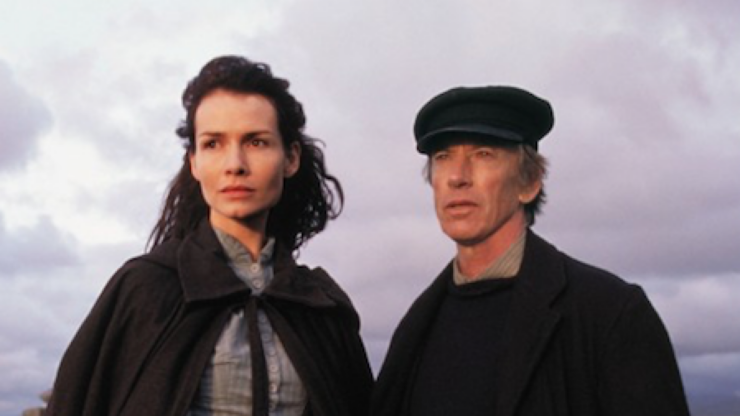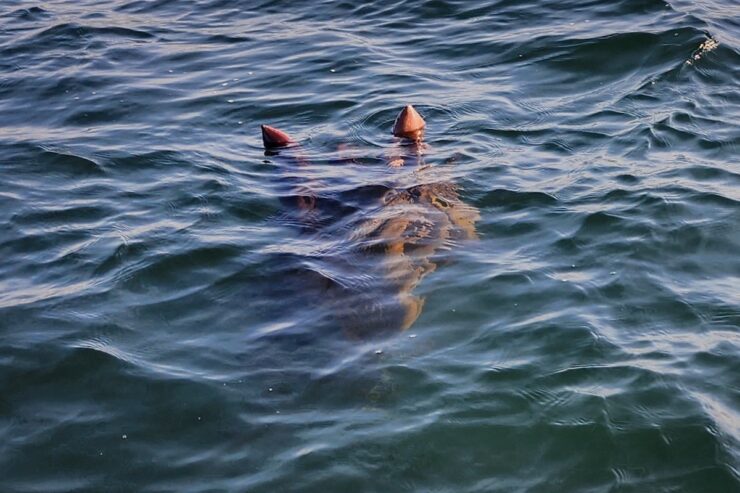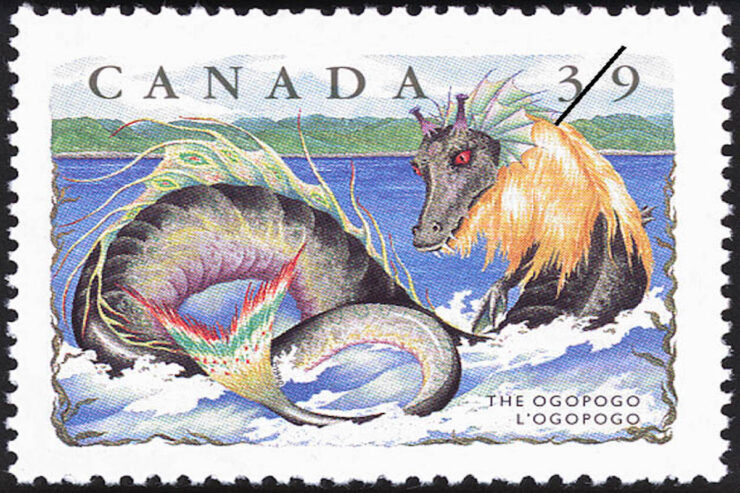The story of the Selkie is, over and over again, a story of domestic abuse. A man takes a woman without her consent, keeps her captive, and forces her to be his sexual partner. Sometimes she submits, or even accepts what has been done to her. But sooner or later, she manages to escape—either by finding her sealskin and returning to the sea, or by dying on land.
John Gray’s TV movie The Seventh Stream takes a somewhat different direction.
The Selkie is captured, her skin hidden, and her captor asserts his dominance over her. He is obsessed with her, but his obsession is not sexual; it’s for money and power. In a time when the fishing off that portion of the Irish coast has dropped away to almost nothing, she fills his boat with fish.
She doesn’t live in his house. He doesn’t claim her as his wife. She’s a means to an end for him, a ticket out of the village and into bigger and better things.
There’s plenty of story there, but in the film, it’s just the beginning. Tomas Dunhill, the man who steals the selkie’s skin, is a catalyst, but he’s not the protagonist. That is Owen Quinn, a fisherman whose wife was lost at sea, and he’s never recovered from the loss. He and his best friend and partner, Willy, run a fishing boat; Tomas is their employee, but when the story begins, he’s found the Selkie and, he thinks, his fortune. He quits the boat and goes off on his own.
Owen and Willy’s part of the story is almost a buddy comedy: easy, lighthearted, as close as brothers. Owen’s grief darkens his whole life, but he’s open to friendship and he’s well respected in the village. He has people who love him, though he keeps to himself; there’s even a woman who has been in love with him since they were children, though he’s oblivious to her transparent yearning.
Owen is a lettered man, a reader of poetry in the evenings after long days at sea. One night as he’s reading in his cottage, he falls into a dream. The shore in front of his house is crowded with seals; they’re singing an eerie song. A darkly beautiful woman sits in the midst of them, and stretches out her arms in entreaty.
Not long after, as Owen and Willy are out fishing, Dunhill rows past them in a small boat full of fish. The woman of Owen’s dream is sitting in the boat. As she passes by, she fixes Owen with a long, deep stare.
Owen is a thoroughly modern man. The year is 1909, and he doesn’t believe in the old stories. And yet, after the woman comes to him again and tells him her story, he finds that he believes her. She is a woman on land, she says, and a seal in the sea; she’s related to the King of Lochlann, who is the king of the seals. “The dark-eyed man took my pelt from me,” she says, and begs him to find it for her. In return, she’ll send the fish to him.
Dunhill’s father Eamonn is blind, and he’s a teller of the old stories. He knows what his son is, and deplores it. He also knows what the woman is.
He tells Owen the rest of the woman’s story. A Selkie can come ashore in human form during the seventh stream, a nine-day period of high tides. She can live on land for a while, but she has to go back to the sea before the next seventh stream.
Selkies, says Eamonn, are wise, but innocent. They can see the truth, and a person must always tell them the truth.
What the Selkie sees is what Eamonn also sees, that Tomas is a selfish, greedy, cruel man. Of the Selkie he says, “I have her pelt, so I have her.” He cares nothing for her at all, only for what she can do for him.
The Selkie is not a passive or a submissive creature. She seeks out Owen because she senses the depth of his sorrow—and his compassion. She sees in him great kindness and great generosity.
They try to find her pelt, but Eamonn has taken it in secret from the place where Tomas hid it. That frees the Selkie from him, though she’s still confined to human form; only Eamonn knows where her pelt is, and he’s keeping it hidden until the time is right.
Tomas, in a rage, tries to force the Selkie to stay with him, but she’s no longer bound to his will. She goes with Owen; he takes her in as a guest, cares for her and feeds and clothes her and gives her gifts. In a word, he courts her, and they come to know each other. She tells him about her world, and he teaches her about his.
Her mind and her culture really are not human. Her world is unconstrained by limits of time or space. There’s no fear of death. No one seeks permanence—in contrast to humans, who are always trying to set boundaries.
She’s particularly fascinated by human memory; by the concept of remembrance. Books interest her, and she learns to read, but real knowledge, she tells Owen, comes from the head and the heart.
They fall in love, inevitably. Owen asks her to marry him. She consents. There’s no force, and no compulsion. It’s her free choice.
While Owen and the Selkie teach one another about their very different worlds, Tomas becomes increasingly desperate. He searches high and low for her pelt. He tries to force her to come back to him.
And then, one morning, fishermen find his body tangled in their nets. Suspicion falls on Owen; he’s arrested for Tomas’ murder. But the Selkie, who can see truth, knows he’s not guilty. She goes to Eamonn and begs him to help Owen.
That’s what Eamonn has been waiting for. He takes her to the place where he hid her pelt, and gives it to her. It’s nearly time for the seventh stream, he says. She has to go back to the sea.
While she agonizes over the choice she now has to make, Eamonn goes to the police and confesses to Tomas’ murder. He’s let go out of pity, because he’s old and blind; the police release him into Owen’s custody.
The Selkie has to go, now she has her pelt. She leaves, and Owen loses it completely. He pitches a roaring fit in his house, tears it apart—and then he’s called down to the harbor. A boat has gone down, and Willy is one of the men who was on it.
Owen leaps into the sea and brings Willy to land, but Willy is gone. The Selkie appears, lays her hand on his heart and he comes back to life. She’s changed her mind; she chooses to stay with Owen.
But she and Eamonn know what Owen doesn’t: that once the tide passes, so will she. That’s the choice. To live in the sea, or to die on land.
At the height of their happiness, she collapses. She sinks rapidly into a coma.
Buy the Book


Under the Smokestrewn Sky
Owen can’t bear to see her die. He takes her out in the teeth of a storm, lays her on a rock in the sea, with her pelt over her, and tries to row away. But the storm takes him. She has to dive into the sea to save him—and by doing that, she makes her final choice. She returns to the form of a seal, and forsakes human form forever.
It’s a complicated story, full of sacrifice and loss, and yet it’s not dark. Owen has two great loves, and strong friendships that endure through all his sorrows. He’s had a rich life, though not always a happy one.
The Selkie has a remarkable amount of free will even in the midst of her captivity. She doesn’t submit meekly; she does everything she can to find her pelt and escape her captor. She has agency, as we say in the editing business.
She’s not only on land because she’s forced to be. She wants to learn about humans. She knows exactly who she is, and what she is. She makes her own choices.
I actually wondered, as I watched the film, if Laurie Brooks had seen it and was inspired by it. It aired on the Hallmark Hall of Fame in 2001; Selkie Girl was published in 2008. Certain details of the novel almost seem to echo the film: the three seals who come to shore in the beginning, the dark man who comes to kill them but steals one of their pelts instead, his raw greed and blind possessiveness. Tomas Dunhill could almost be Elin Jean’s father. Even her mother bears some resemblance to the Selkie of the film, in her incarnation as a teller of stories.
Whether or not that’s the case, the novel and the film fit well together. The novel is much darker, the film much gentler, but they share the same love of the sea, and the same deep magic.
Judith Tarr is a lifelong horse person. She supports her habit by writing works of fantasy and science fiction as well as historical novels, many of which have been published as ebooks. She’s written a primer for writers who want to write about horses: Writing Horses: The Fine Art of Getting It Right. She lives near Tucson, Arizona with a herd of Lipizzans, a clowder of cats, and a blue-eyed dog.














